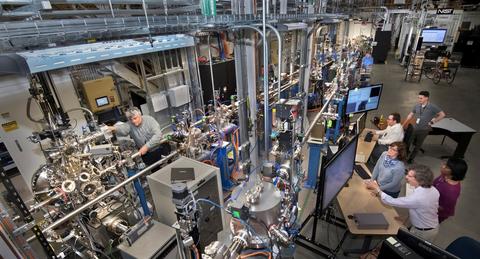Spectroscopy Soft and Tender (SST)

The NIST Synchrotron Science Group working at the SST-I (middle front) and SST-II (front left) beamlines. In the background, the safety hutch for the hard X-ray beamline BMM can be seen (top right).
The Spectroscopy Soft and Tender (SST-I and SST-II) beamlines provide X-ray beams in the "soft" (0.1 keV to 2.2 keV) and the "tender" (2.0 keV to 7.5 keV) energies. Together, the spectroscopy beamlines direct beam to 7 experimental stations. Five stations are operated exclusively with soft X-rays provided by SST-I. Two of the stations can receive beam from either SST-I or SST-II. To fully realize the power of such a large range in available photon energies, the beams are designed to both provide the new full field vector potential photoemission microscope (VPPEM) with a 10 micron spot size at the same spatial location. This requirement dictated the placement of the insertion devices at a low beta straight section of the NSLS-II.
The pair of spectroscopy beamlines are served by two insertion devices symmetrically canted at an angle of 2 mrad. SST-I is built off of a 0.84 meter long elliptically polarized undulator to deliver 0.1 keV to 2.2 keV photons. SST-I is based on a variable line spacing plane grating monochromator capable of delivering a resolving power higher than 20,000 over its full energy range. SST-II is built from a 1.6 m, 42 period (U-42) elliptically polarized undulator. The optical system employs a double-crystal monochromator with Si(111) and Si(220) crystals, and five mirrors to guide and focus the beam on samples in the two end stations. The optical system allows tuning of the beam spot size in a range of 10 to 50 µm.
SST-I and SST-I are two of the three beamlines built through a partnership with Brookhaven National Laboratory at the National Synchrotron Light Source (NSLS-II). The beamline suite is designed to provide key measurement capabilities needed to advance applications in material science including energy, health, environment, and national security. In addition to SST-I and SST-II, NIST operates the Beamline for Materials Measurement (BMM) in the hard X-ray energies. Together, the beamlines provide options for beam energy to probe the excitation edges of core electrons across the entire periodic table. In addition to the leading spectroscopy capabilities that continue to develop in experimental stations across BMM and SST-I, SST-II features a novel capability developed by the Synchrotron Science Group to bring both soft and tender beams into both end stations. This capacity provides a world class measurement capability due to the enormous range of X-ray energies available to techniques that use the energy spectrum to both probe atomic and electronic structure, while also leveraging the energy to control the depth of the measurement.
Soft X-ray Experimental Stations (SST-I)
Resonant Soft X-ray Scattering (RSoXS)
Soft X-ray Adsorption and Emission (μCAL)
Large Area Rapid Imaging Tool MK I (LARIAT I)
Near Edge X-ray Absorption Fine Structure (NEXAFS)
Large Area Rapid Imaging Tool MK II (LARIAT II)
Soft or Tender X-ray Experimental Stations (SST-II)
Hard X-ray Photoelectron Spectroscopy (HAXPES)
Vector Potential Photoelectron Microscope (VPPEM)
Contacts
Beamline Scientists
-
(631) 344-5958
-
(631) 344-5177
-
(631) 344-4225

